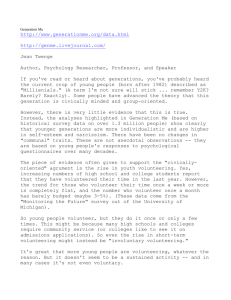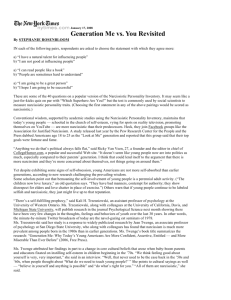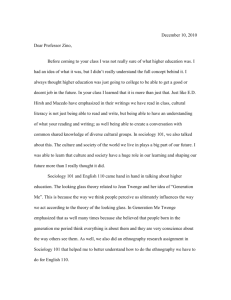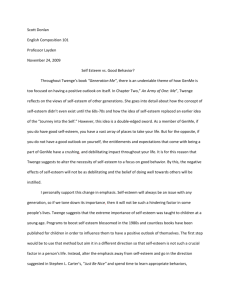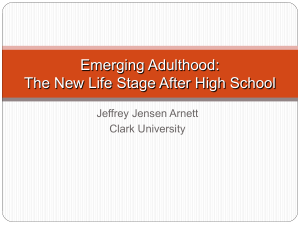. - Jeffrey Arnett
advertisement
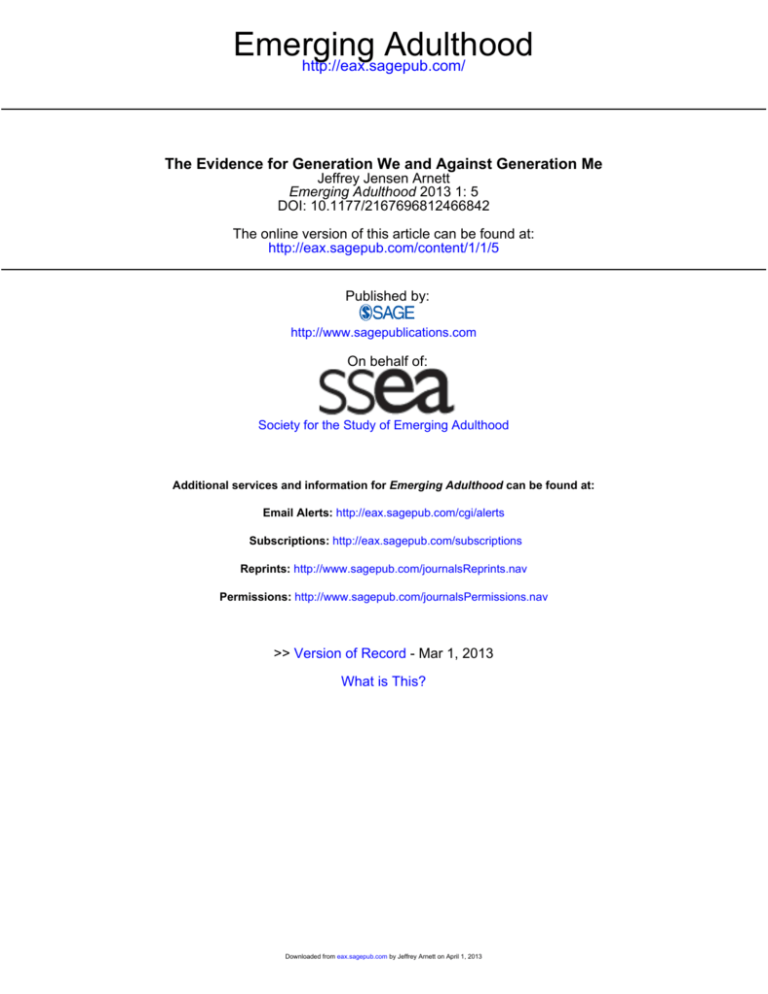
Emerging Adulthood http://eax.sagepub.com/ The Evidence for Generation We and Against Generation Me Jeffrey Jensen Arnett Emerging Adulthood 2013 1: 5 DOI: 10.1177/2167696812466842 The online version of this article can be found at: http://eax.sagepub.com/content/1/1/5 Published by: http://www.sagepublications.com On behalf of: Society for the Study of Emerging Adulthood Additional services and information for Emerging Adulthood can be found at: Email Alerts: http://eax.sagepub.com/cgi/alerts Subscriptions: http://eax.sagepub.com/subscriptions Reprints: http://www.sagepub.com/journalsReprints.nav Permissions: http://www.sagepub.com/journalsPermissions.nav >> Version of Record - Mar 1, 2013 What is This? Downloaded from eax.sagepub.com by Jeffrey Arnett on April 1, 2013 State of the Field The Evidence for Generation We and Against Generation Me Emerging Adulthood 1(1) 5-10 ª 2013 Society for the Study of Emerging Adulthood and SAGE Publications Reprints and permission: sagepub.com/journalsPermissions.nav DOI: 10.1177/2167696812466842 ea.sagepub.com Jeffrey Jensen Arnett1 Abstract This article addresses the question of whether today’s emerging adults are excessively ‘‘narcissistic’’ as claimed by Jean Twenge and others. The answer is a decisive ‘‘no.’’ There is no persuasive evidence that scores on the Narcissistic Personality Inventory (NPI) have risen among college students in recent decades. In any case, the NPI is a dubious measure of narcissism, and college students are a dubious sample of emerging adults. There is evidence that today’s emerging adults have high expectations and are confident in their abilities, but these qualities should be seen as psychological resources during a life stage that is often difficult. If it were true that their narcissism was rising and that narcissism leads to impulsive behavior, then impulsive behavior would also be rising, but in fact it is diminishing across multiple indicators. As a society, we can and should do more to support emerging adults, beginning with a halt to the negative stereotypes. Keywords health behavior, well-being, self esteem, antisocial behavior, anxiety In the course of the 20 years I have been interviewing and writing about emerging adults, I have often been puzzled and troubled by the many negative stereotypes that have collected around them. Books are written about them with hostile, sneering titles such as The Dumbest Generation and Slouching Toward Adulthood. When I talk to people about my research, the most common question is some version of ‘‘What is wrong with them?’’ Of course, bashing the young is old tradition (Arnett, 2008). From Aristotle’s time to Shakespeare’s to our own, adults have lamented the deficiencies of the rising generation and deplored their inadequacy for taking on the responsibilities of adulthood. These laments are not entirely without foundation, given that, in most times and places, it is the young who are the source of the most crime, sexual misbehavior, and other behavior that is disruptive to the functioning of society (Arnett, 1999). However, what makes the volume of the current complaints especially puzzling is that it is so out of sync with the reality of young people’s lives. As I will explain here, across a wide range of indicators, the behavior of young people has become better, not worse, over the past 20 years. Nevertheless, the complaints continue, along with claims that they are worse than ever. Jean Twenge’s research and writings have been at the forefront of today’s complaints about young people. In her book Generation Me (Twenge, 2006) and in a series of research articles, Twenge has sought to advance the thesis that today’s emerging adults are exceptionally selfish, even ‘‘narcissistic’’ (Twenge & Campbell, 2001, 2010; Twenge & Foster, 2010; Twenge, Konrath, Foster, Campbell, & Bushman, 2008). Due to the indulgent attitudes of their parents, who were bred in the era of 1960s and ‘70s when the self-esteem movement was in its heyday, today’s emerging adults experienced a childhood in which they were rarely scolded for misbehavior, and every kid on the soccer team received a trophy, regardless of performance. Consequently, goes Twenge’s thesis, they reached emerging adulthood with their self-esteem inflated to the point of narcissism, with disastrous consequences for themselves and their society. Twenge deserves credit for delivering a well-deserved skewering to the excesses of the self-esteem movement (although she is hardly the first to do so). I agree entirely with her assertion that self-control is a stronger predictor than selfesteem of outcomes such as higher educational attainment and lower substance use. However, I disagree with her claims about emerging adults, in particular their alleged narcissism. I do not believe the evidence supports her views that today’s emerging adults are fundamentally selfish as a consequence of overindulgent parenting and consequently pose a danger to society and to their own futures. On the contrary, my view is directly opposite: that today’s emerging adults are not Generation Me but Generation We, an exceptionally generous generation that holds great promise for improving the world. Our debate centers around three questions. 1 Clark University, Worcester, MA, USA Corresponding Author: Jeffrey Jensen Arnett, PhD, 950 Main St, Worcester, MA 01610, USA. Email: arnett@jeffreyarnett.com Downloaded from eax.sagepub.com by Jeffrey Arnett on April 1, 2013 6 Emerging Adulthood 1(1) Is Narcissism—An Inflated Sense of Self—Increasing Among Emerging Adults? In her book and in many published articles, the focus of Twenge’s research has been on presenting evidence purported to show an increase in narcissism among emerging adults in recent decades. As the basis of this assertion, she has conducted meta-analyses on studies of college students that include the Narcissistic Personality Inventory (NPI; Twenge & Foster, 2010). She has also examined cohort patterns in college students’ self-esteem (Gentile, Twenge, & Campbell, 2010; Twenge & Campbell, 2001). However, there are several reasons to question Twenge’s evidence, specifically (1) the dubious validity of the NPI as a measure of narcissism; (2) Twenge’s reliance on college student samples to represent all emerging adults, and (3) contradictory data showing little or no rise in narcissism or self-esteem. Does the NPI really measure narcissism? The NPI is a 40-item questionnaire. Some of the items have clear face validity as assessments of narcissism, such as ‘‘I like to show off my body’’ and ‘‘If I ruled the world it would be a better place.’’ In contrast, other items seem well within the range of normal personality and may even be considered to reflect desirable traits, such as ‘‘I am assertive’’ and ‘‘I Iike to take responsibility for making decisions.’’ The increase in scores on the NPI over several decades that Twenge reports is small, amounting to only an item or two (Donnellan, Trzesniewski, & Robins, 2009). So, which items are responsible for the increase, the items showing psychopathology or the items showing normal or even optimal traits? Because Twenge’s analyses use the total scale, there is no way to tell. One analysis that examined NPI subscales did not support Twenge’s thesis (Trzesniewski, Donnellan, & Robins, 2008a). Notably, there is a gender difference in patterns of scores on the NPI over recent decades, with studies that compare males and females showing an increase only for females (Trzesniewski, Donnellan, & Robins, 2008b; Twenge et al., 2008). Gender roles have also changed in recent decades, with young females increasing on traditionally ‘‘masculine’’ personality traits such as assertiveness (Choi, Fuqua, & Newman, 2008; Twenge, 1997). So, the increase in narcissism Twenge reports among females could simply reflect changes in gender roles, with young women today more likely to be assertive and selfconfident than in the past. Do college students adequately represent emerging adults? Twenge’s data on emerging adults combine studies of college students over several decades. She then presents the results as conclusions about all ‘‘young Americans’’ (Twenge, 2006). However, college students are not representative of emerging adults more generally. They are wealthier, Whiter, and (by definition) more highly educated than their noncollege peers. Furthermore, the studies used by Twenge are not representative even of college students. Although 70% of young Americans enter higher education the year after graduating from high school, half of these attend community colleges or vocational training programs (National Center for Education Statistics, 2011). Twenge’s data are drawn entirely from the college students who attend 4-year colleges and who represent only 20% of all young Americans aged 18–25 (Trzesniewski et al., 2008b). Have narcissism scores really increased? Even if we were to accept that the NPI is a valid measure of narcissism, and even if we were to accept that college students can be taken to represent all emerging adults, there would still be reason to doubt Twenge’s conclusion that narcissism has increased among young Americans in recent decades. Other researchers who have examined her analyses of trends among college students have disputed her results and have reached different conclusions in their own analyses. The critique of Twenge’s claims of growing narcissism among college students has been led by Kali Trzesniewski and Brent Donnellan. In a series of papers, they have carefully examined each of Twenge’s analyses, and each time concluded that Twenge’s claims for her data are unmerited (Donnellan et al., 2009; Trzesniewski & Donnellan, 2010; Trzesniewski et al., 2008a, 2008b). Trends in narcissism, self-esteem, and self-enhancement among college students are flat over several decades, according to their analyses. For example, Trzesniewski, Donnellan, and Robins (2008a) examined patterns in self-esteem from 1976 to 2005, using data from the Monitoring the Future Project, a large annual survey that is representative of American high school seniors. Self-esteem is a particularly apt choice, given Twenge’s (2006) claims that the basis of the narcissism of today’s college students is the inflated self-esteem they developed in the course of childhood. However, the analysis by Trzesniewski et al. (2008a) showed no increase in self-esteem from the mid-1970s to the present. Other investigators have reached similar conclusions. Most notably, Roberts, Edmonds, and Grijalva (2010) reexamined the conclusions presented in Twenge, Konrath, Foster, Campbell, and Bushman (2008) of secular trends among college students on the NPI. The analyses by Roberts et al. (2010) included additional studies that were not part of the Twenge et al. (2008) analysis. A comparison of the two studies is shown in Figure 1. The Twenge et al. analysis showed a slight rise from 1982–90 to 2006 (although only slight; scores as of 2003 were little different from scores of 1982–90). However, the analysis by Roberts et al. (2010) showed no increase at all. Is an Inflated Sense of Self Good or Bad in Emerging Adulthood? Is There a Point at Which It Becomes Too High, and If So, How Can That Point Be Identified? Although narcissism and self-esteem among American emerging adults do not appear to have changed over the past Downloaded from eax.sagepub.com by Jeffrey Arnett on April 1, 2013 Arnett 7 Figure 1. Cohort changes on narcissism as measured by the NPI, Roberts et al. (2010) (diamonds) and Twenge et al. (2008) (squares). several decades, it seems clear that emerging adulthood is a time when optimism is especially high. In the recent national Clark University Poll of Emerging Adults (CUPEA) I directed, 83% of 18- to 29-year-olds agreed with the statement, ‘‘At this time of my life it still seems like anything is possible,’’ and 89% agreed that ‘‘I am confident that eventually I will get what I want out of life’’ (Arnett & Schwab, 2013). Even narcissism, as measured by the NPI, may be higher in emerging adulthood than in other adult life stages. Roberts et al. (2010) examined patterns of scores on the NPI in the course of adulthood. They found that NPI scores were highest of all during emerging adulthood and concluded that ‘‘every generation is Generation Me, as every generation of young people is more narcissistic than their elders’’ (p. 97). Of course, this conclusion must be interpreted in light of the concerns about the validity of the NPI as a measure of narcissism. Nevertheless, it appears to be broadly true that young Americans have high expectations for life and high hopes that those expectations will eventually bear fruit. On this point, I believe Twenge and I can agree. However, a crucial point of disagreement immediately follows, regarding the implications and consequences of emerging adults’ high expectations. Twenge’s thesis is not just that high expectations (narcissism) are high in emerging adulthood, but that the consequences of these high expectations are ruinous for emerging adults and for society. Specifically, Twenge claims that an inflated sense of self in emerging adulthood can be linked to mental health problems such as anxiety and depression as well as to poor relationships, impulsive, and irresponsible sexual behavior, and a lack of concern with the problems of society as a whole (Twenge, 2006). Yet the evidence on anxiety and depression is mixed at best, and the evidence on relationships and behavior is overwhelmingly against Twenge’s thesis. Twenge (2006) claims that anxiety and depression have increased in recent cohorts of children, adolescents, and emerging adults. However, other evidence calls this claim into question (Trzesniewski & Donnellan, 2010). A meta-analysis of epidemiological studies of depression over the last 30 years reported no changes in prevalence of depression in childhood and adolescence (Costello, Erkanli, & Angold, 2006). Epidemiological studies focusing on emerging adults have not been conducted, except on college student samples, which are suspect for the reasons mentioned above. Nevertheless, even if the evidence does not support Twenge’s claim that anxiety and depression have increased in childhood and adolescence, I agree with Twenge that emerging adulthood is a stage of life when anxiety and depression are high. In the national CUPEA survey of 18- to 29-year-olds conducted in 2012, 56% agreed with the statement ‘‘I often feel anxious’’ and 32% agreed that ‘‘I often feel depressed’’ (Arnett & Schwab, 2013). However, in the same survey, 83% of emerging adults agreed that ‘‘This time of my life is fun and exciting.’’ Clearly, emerging adulthood is an emotionally complicated life stage. There is an additional question as to the sources of emerging adults’ widespread anxiety and depression, and here Twenge and I see it differently. She attributes their anxiety and depression to the self-esteem that was overinflated during their childhood years, leading inevitably to deflation once their dreams collide with reality in emerging adulthood. As she states in Generation Me, ‘‘Our growing tendency to put the self first leads to unparalleled freedom, but it also creates an enormous amount of pressure on us to stand alone . . . Generation Me has been taught to expect more out of life at the very time when good jobs and nice houses are increasingly difficult to obtain. All too often, the result is crippling anxiety and crushing depression’’ (Twenge, 2006, p. 109). My view is that anxiety and depression in emerging adulthood are not a consequence of inflated self-esteem earlier in development but of the identity struggles that are a normal part of the emerging adulthood life stage, in love and work (Arnett, 2004). In the course of the 20s, most young Americans find a life partner with whom to form a committed relationship, usually culminating in marriage, but in the course of finding that partner they make and break a series of relationships. They also have periods when they have no partner. It is not surprising that the ups and downs of their love lives would be accompanied by emotions of anxiety and depression. Similarly, their efforts to find satisfying work involve changing jobs often, an average of seven times from age 20 to 29. Unemployment rates among 16- to 24-year-olds are consistently twice as high as the overall rate. Each new job may provoke anxiety, as may each jobless period; losing a job, or working in an unpromising, low-paying job may provoke feelings of depression. The high expectations and optimism of emerging adults, far from being a bane to themselves or society, are actually a psychological resource during what is often a stressful and difficult time of life (cf. Bjorklund, 1997). Because they are making their way toward building the foundation of an adult life and trying possibilities that often do not work out well for them and require them to try something else, they are frequently knocked down in the course of their 20s. Their optimism, their selfbelief, is what enables them to get up and try again (Arnett, 2004). Downloaded from eax.sagepub.com by Jeffrey Arnett on April 1, 2013 8 Emerging Adulthood 1(1) If self-esteem in emerging adulthood is a psychological asset for most of them, is there a point at which it becomes too high for some? No doubt there is a point at which high selfesteem becomes egocentrism or even narcissism. However, a threshold point is impossible for psychology to identify with precision. Psychological measures do not possess such exactness. The question could be addressed more successfully if applied to this generation of emerging adults as a whole. Specifically, is the self-esteem of today’s emerging adults so high that it becomes selfishness or narcissism for many of them and consequently causes problems for themselves and for society? This is the question that Twenge answers affirmatively in her work; hers is an indictment of an entire generation. With regard specifically to narcissism, Twenge asserts that there are ‘‘hundreds of studies showing that the NPI predicts an array of negative outcomes, from aggression after threat to lack of empathy’’ (2008, p. 684). If narcissism has increased in recent decades among emerging adults, and if it is true that narcissism predicts ‘‘an array of negative outcomes,’’ then these negative outcomes should be abundantly evident in the lives of today’s emerging adults. However, the evidence overwhelmingly contradicts her declaration. If Twenge’s claim were true, the results of it would be evident in the behavior of today’s emerging adults. They would exhibit rising rates of impulsive, risky behavior, because they would lack adequate self-control and they would feel entitled to any impulsive pleasure they might wish to pursue. They would exhibit low rates of empathy for others and do little to help anyone other than themselves, because they would be trapped in the cocoon of their narcissism. In direct contradiction to Twenge’s claims, rates of risk behavior have undergone a remarkable decline in the past 20 years over a wide range of behaviors. At the same time, emerging adults today show unprecedented acceptance for people who are different from themselves and are participating in community service at record high rates. The decline in risk behavior applies to automobile driving, teen pregnancy, and crime. Automobile fatalities among 16- to 24-year-olds declined by almost half from 1990 to 2009 (National Highway Traffic Safety Administration [NHTSA], 2011). Because risky driving behavior is a principal cause of accidents among young drivers, it can be inferred that their driving behavior is more responsible and less impulsive today than it was 20 years ago. Rates of pregnancy, abortion, and childbirth among 15- to 19-year-olds also declined by nearly half from 1990 to 2010 (Centers for Disease Control and Prevention [CDC], 2011; National Center for Health Statistics, 2012). This implies that young people today are more responsible and less impulsive in their sexual behavior than they were 20 years ago. With regard to crime, the same pattern of declineby-half over the past 20 years applies to property crimes (Office of Juvenile Justice and Delinquency Prevention, 2011). Violent crime has decreased as well, by about one third. Criminologists have long identified impulsiveness as a major contributor to criminal behavior (Cross, Copping, & Campbell, 2011), so the decline in crime implies a decline in impulsiveness among the young. Not only have negative behaviors decreased but positive behaviors have increased. According to the annual national survey of tens of thousands of college freshmen conducted by the Higher Education Research Institute, 84% reported volunteering within the past year in 2008, the highest level ever and up steadily from 66% in 1990 (Pryor et al., 2008; Pryor, Hurtado, Saenz, Santos, & Korn, 2007). Furthermore, attitudes toward persons of different ethnicities and sexual orientations are more tolerant and accepting among young people today than among older generations (Zogby, 2008). For example, in a national sample 50% of 18- to 29-year-olds approved of legalizing gay marriage, a higher percentage than in any older age group (Pew Research Center, 2010). It seems reasonable to conclude that young people today are better, not worse, at taking the perspective of persons who are different than themselves, compared to their elders, and consequently less, not more, egocentric or narcissistic. In sum, the evidence overwhelmingly shows that the self-esteem and self-belief of today’s emerging adults is not ‘‘too high’’ by any reasonable reckoning. If it were, the consequences would be evident in high and increasing rates of selfish attitudes and impulsive behavior. Instead, emerging adults have been shown to be less selfish and impulsive in their attitudes and behavior than they were 20 years ago. They are a generation that should be commended for the improvements in their behavior and heralded for their promise in creating a more generous and accepting society. For Twenge to slander them instead as selfish, impulsive, and narcissistic is patently inaccurate and deeply unfair. How, If at All, Should We Change Our Culture (Parenting, Teaching, and Media) to Benefit the Next Generation of Emerging Adults? Given all the favorable trends in young people’s attitudes and behavior over the past 20 years, whatever we have been doing in our socialization of children, we should keep doing it. Clearly, it is working well. They are growing into emerging adults who are less likely than in the past to participate in risk behaviors that endanger the health and well-being of themselves and others, as well as more likely to be accepting of people who are unlike themselves and to engage in community service. Despite Twenge’s claims of the doom and gloom that should result from the supposedly inflated self-esteem of today’s emerging adults, there is no evidence whatsoever that their functioning is worse than in the past. However, this does not mean we should be complacent. One specific policy we can advocate is to broaden the range of opportunities for emerging adults to express their generosity and their desire to help others and improve society. Community service organizations such as the Peace Corps and Americorps are currently experienced record numbers of applications from Downloaded from eax.sagepub.com by Jeffrey Arnett on April 1, 2013 Arnett 9 emerging adults. However, their capacity has not expanded along with their applications, and they can only accept about 10% of the young people who apply. This means that many emerging adults lose an opportunity to serve, and the people whom they would serve lose as well. The capacity of these organizations should be multiplied so that all the emerging adults who wish to serve and who possess adequate skills for the service required are able to do so. The benefits would be substantial, for emerging adults and the world. The other step that can be taken for the benefit of emerging adults is to stop promoting negative stereotypes about them, that they are selfish, lazy, and worse than ever. These false claims are harmful, not only because they are false and therefore unfair but because they discourage adult society from supporting the programs that would give emerging adults a broader range of opportunities for education, work, and service. It is time to retire the damaging and false stereotypes and instead celebrate today’s emerging adults for the extraordinary generation they are. Author’s Note I am grateful to Kali Trzesniewski and Brent Donnellan for their comments on a draft of this article. The article is based on my half of a debate with Jean Twenge conducted at the 5th biennial Conference on Emerging Adulthood, Providence, Rhode Island, October 2011. Declaration of Conflicting Interests The author declared no potential conflicts of interest with respect to the research, authorship, and/or publication of this article. Funding The author received no financial support for the research, authorship, and/or publication of this article. References Arnett, J. J. (1999). Adolescent storm and stress, reconsidered. American Psychologist, 54, 317-326. Arnett, J. J. (2004). Emerging adulthood: The winding road from the late teens through the twenties. New York, NY: Oxford University Press. Arnett, J. J. (2008). Storm and stress redux. American Journal of Psychology, 121, 675-682. Arnett, J.J., & Schwab, J. (2013). The Clark University Poll of Emerging Adults, 2012: Thriving, struggling, and hopeful. Worcester, MA: Clark University. Bjorklund, D. F. (2007). Why youth is not wasted on the young: Immaturity in human development. Oxford, England: Blackwell. Centers for Disease Control and Prevention. (2011). About teen pregnancy. Retrieved on October 24, 2011, from http://www.cdc.gov/ TeenPregnancy/AboutTeenPreg.htm#PTP1 Choi, N., Fuqua, D. R., & Newman, J. L. (2008). The bem sex role inventory: Continuing theoretical problems. Educational and Psychological Measurement, 68, 881-900. Costello, E. J., Erkanli, A., & Angold, A. (2006). Is there an epidemic of child or adolescent depression? Journal of Child Psychology and Psychiatry, 47, 1263-1271. Cross, C. P., Copping, L. T., & Campbell, A. (2011). Sex differences in impulsivity: A meta-analysis. Psychological Bulletin, 137, 97-130. Donnellan, M. B., Trzesniewski, K. H., & Robins, R. W. (2009). An emerging epidemic of narcissism or much ado about nothing? Journal of Research in Personality, 43, 498-501. Donnellan, M. B., Trzesniewski, K. H., Robins, R. W., Moffitt, T. E., & Caspi, A. (2005). Low self-esteem is related to aggression, antisocial behavior, and delinquency. Psychological Science, 16, 328-335. Gentile, B., Twenge, J. M., & Campbell, W. K. (2010). Birth cohort differences in self-esteem, 1988-2008. Review of General Psychology, 14, 261-268. National Center for Education Statistics (2011). The condition of education, 2011. Washington, DC: Author. National Center for Health Statistics. (2012). Birth rates for U.S. teenagers reach historic lows for all ages and ethnic groups. NCHS Data Brief, Number 89. Hyattsville, MD: Author. National Highway Traffic Safety Administration. (2011). Traffic safety facts, 2009. Washington, DC: Author. Office of Juvenile Justice and Delinquency Prevention (2011). Statistical briefing book. Retrieved on April 23, 2012, from http://www.ojjdp.gov/ojstatbb/crime/JAR.asp Pew Research Center. (2010). Millennials: A portrait of Generation Next. Washington, DC: Author. Pryor, J. H., Hurtado, S., DeAngelo, L., Sharkness, J., Romero, L. C., Korn, W.S., & Tran, S. (2008). The American freshman: National norms for fall 2008. Los Angeles, CA: Higher Education Research Institute. Pryor, J. H., Hurtado, S., Saenz, V. B., Santos, J. L., & Korn, W. S. (2007). The American freshman: Forty year trends. Los Angeles, CA: Higher Education Research Institute. Roberts, B. W., Edmunds, G., & Grijalva, E. (2010). It’s developmental me, not Generation Me: Developmental changes are more important than generational changes in narcissism. Commentary on Trzesniewski & Donnellan (2010). Perspectives in Psychological Science, 5, 97-102. Trzesniewski, K. H., & Donnellan, M. B. (2010). Rethinking ‘‘Generation Me’’: A study of cohort effects from 1976-2006. Perspectives in Psychological Science, 5, 58-75. Trzesniewski, K. H., Donnellan, M. B., & Robins, R. W. (2008a). Do today’s young people really think they are so extraordinary? An examination of secular trends in narcissism and self-enhancement. Psychological Science, 19, 181-188. Trzesniewski, K.H., Donnellan, M.B., & Robins, R.W. (2008b). Is ‘‘Generation Me’’ really more narcissistic than previous generations? Journal of Personality, 76, 903-918. Twenge, J. M. (1997). Changes in masculine and feminine traits over time: A meta-analysis. Sex Roles, 36, 305-325. Twenge, J. M. (2006). Generation Me: Why today’s young Americans are more confident, assertive, entitled – and more miserable than ever before. New York, NY: Free Press. Twenge, J. M. (2008). Excellent and accessible view of emerging adulthood. American Journal of Psychology, 121, 682-687. Twenge, J. M., & Campbell, W. K. (2001). Age and birth cohort differences in self-esteem: A cross-temporal meta-analysis. Personality and Social Psychology Review, 5, 321-344. Downloaded from eax.sagepub.com by Jeffrey Arnett on April 1, 2013 10 Emerging Adulthood 1(1) Twenge, J. M., & Campbell, W. K. (2010). Birth cohort differences in the monitoring the future dataset and elsewhere: Further evidence for Generation Me. Perspectives in Psychological Science, 5, 81-88. Twenge, J. M., & Foster, J. D. (2010). Birth cohort increases in narcissistic personality traits among American college students, 1982– 2009. Social Psychological and Personality Science, 1, 99-106. Twenge, J. M., Konrath, S., Foster, J. D., Campbell, W. K., & Bushman, B. J. (2008). Egos inflating over time: a cross-temporal meta-analysis of the Narcissistic Personality Inventory. Journal of Personality, 76, 875-902. Zogby, J. (2008). The way we’ll be: The Zogby Report on the transformation of the American dream. New York: Random House. Author Biography Jeffrey Jensen Arnett is a research professor at Clark University. He is the author of Emerging Adulthood: The Winding Road from the Late Teens Through the Twenties (Oxford University Press) and the Founding President of the Society for the Study of Emerging Adulthood (SSEA; www.ssea.org). Downloaded from eax.sagepub.com by Jeffrey Arnett on April 1, 2013
